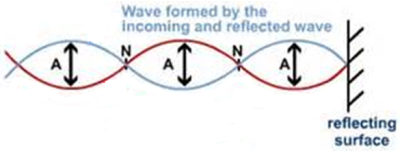Course description
Wave motion:
Wave motion can be thought of as the transport of energy and momentum from one point in space to another point without the transport of matter (Fig. 10 a). Water waves, sound waves, light waves and radio waves are the examples to carry energy from one place to another (Fig. 10 b, c, d, e). In the case of water and sound waves, a medium is necessary which possess inertia as well as elasticity and therefore, these wave motions are referred to as mechanical waves. In the case of light and radio waves, no intervening medium is at all necessary and are therefore, referred to as non-mechanical or electromagnetic waves.
A wave motion, which progresses onwards through a medium, with energy transferred across every section of it, is called a travelling or a progressive wave motion (Fig. 10 f, g). However, if there is no onward movement of the wave motion through the medium and hence no transference of energy across any section of it then it is called a standing or stationary wave motion (Fig. 10 h). There are two distinct types of wave motion:
(i) transverse and (ii) longitudinal.
In transverse wave motion, (Fig. 10 f) the particles of the medium oscillate up and down about their mean or equilibrium position in a direction at right angles to the direction of propagation of the wave motion itself. Transverse wave motion is possible in media which possess elasticity of shape or rigidity, i.e., solids. Although water or liquids do not possess the property of rigidity, but due to possess another equally effective property of resisting any vertical displacement of their particles, transverse wave motion is still possible in liquids. Light or water waves are the examples of this type of wave motion.
In longitudinal wave motion, (Fig. 10 g) the particles of the medium oscillate to and fro about their mean or equilibrium position, along the direction of propagation of the wave motion itself. This type of wave motion is possible in media possessing elasticity of volume, i.e., in solids, liquids as well as gases. Sound wave in air is the example of this type of wave motion.
Stationary wave: A medium in which a wave is constrained to travel along a fixed linear path may be unlimited or limited length. When the length of the medium be limited or finite, it is referred to as a linear bounded medium. If a wave travelling through the finite medium, will suffer normal reflection at the boundary. When two identical waves of the same wavelength, frequency and amplitude, travelling along the same linear path but in opposite directions will superpose on each other and the result is a very special case of interference in which the positions of maximum and minimum displacement remain fixed throughout (Fig. 16 a, b, c). The resulting waves appear to remain stationary in space, with no onward or progressive movement. For this reason, the resulting waves are referred to as the stationary or standing waves.
The nature of the boundary of the linear medium where the reflection takes place may be fixed (rigid) or free (yielding) (Fig. 16 d). Suppose a
wave pulse travels to a fixed end of a stretched string (Fig. 16 e). Upon arrival at the end, the wave pulse exerts an upward force on the support. However, the support is rigid and as such dose not move. But according to Newton’s third law, the support also exerts an equal but oppositely directed force on the string and hence generates a wave pulse (called reflected wave) at the support, which travels back along the string in a direction opposite to that of the incident pulse. Since the reflected wave is always 1800 out of phase with the incident wave at a fixed boundary, the resultant displacement of the particle there will be zero. Therefore, we have a standing wave of zero displacement at the fixed end of a string. Let us now consider the reflection of a pulse at a free end of a stretched string, i.e., at an end that is free to move transversely- the so-called yielding wall (Fig. 16 f). Upon arrival at the free end, the wave pulse exerts a force on the element of string there. This element is accelerated and its inertia carries it past the equilibrium point; it overshoots and exerts a reaction force on the string. This reaction force generates a pulse, which travels back along the string in a direction opposite to that of the incident pulse. Moreover, the reflected wave is always in phase with the incident wave at the free end. Hence, the free end will suffer the maximum displacement of the particles on the string. Thus, we have a standing wave of maximum displacement at a free end of a string.


















